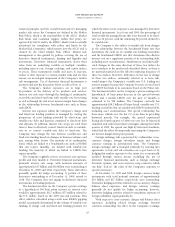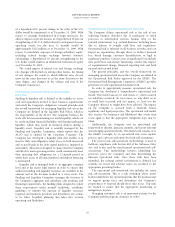American Express 2009 Annual Report Download - page 57
Download and view the complete annual report
Please find page 57 of the 2009 American Express annual report below. You can navigate through the pages in the report by either clicking on the pages listed below, or by using the keyword search tool below to find specific information within the annual report.
2009 FINANCIAL REVIEW
AMERICAN EXPRESS COMPANY
SELECTED STATISTICAL INFORMATION(a)
As of or for the Years Ended December 31,
(Billions, except percentages
and where indicated) 2009 2008 2007
Card billed business $ 94.9 $106.1 $ 98.0
Total cards-in-force (millions) 15.0 16.3 16.0
Basic cards-in-force (millions) 10.5 11.4 11.3
Average basic cardmember spending
(dollars) $8,758 $9,292 $8,772
International Consumer Travel:
Travel sales (millions) $ 985 $1,267 $1,113
Travel commissions and fees/sales 8.6% 8.1% 8.6%
Total segment assets $ 20.4 $ 20.4 $ 21.4
Segment capital (millions)(b) $2,164 $1,997 $2,062
Return on average segment capital(c) 14.3% 16.7% 15.3%
Return on average tangible segment
capital(c) 19.3% 22.5% 21.4%
Cardmember receivables:
Total receivables $ 5.9 $ 5.6 $ 6.6
90 days past billing as a % of total(d) 2.1% 3.1% 1.8%
Net loss ratio as a % of charge volume 0.36% 0.24% 0.26%
Cardmember loans:
Total loans $ 9.2 $ 9.5 $ 11.2
30 days past due loans as a % of total 3.3% 3.6% 2.8%
Average loans $ 8.9 $ 10.9 $ 10.0
Net write-off rate 6.8% 4.8% 4.9%
Net interest income divided by
average loans(e)(f) 12.1% 9.4 % 8.3%
Net interest yield on cardmember
loans(e) 11.9% 9.8% 8.9%
(a) See Glossary of Selected Terminology for the definitions of certain
key terms and related information.
(b) Segment capital at the end of each respective period represents
capital allocated to a segment based upon specific business
operational needs, risk measures, and regulatory capital
requirements.
(c) Return on average segment capital is calculated by dividing
(i) segment income ($303 million, $351 million, and $291 million
for 2009, 2008, and 2007, respectively) by (ii) average segment
capital ($2.1 billion, $2.1 billion, and $1.9 billion for 2009, 2008,
and 2007, respectively). Return on average tangible segment
capital is computed in the same manner as return on average
segment capital except the computation of average tangible
segment capital excludes average goodwill and other intangibles
of $551 million, $544 million, and $539 million as of
December 31, 2009, 2008, and 2007, respectively. The Company
believes the return on average tangible segment capital is a useful
measure of the profitability of its business.
(d) A cardmember account is considered 90 days past billing if
payment has not been received within 90 days of the
cardmember’s billing statement date. In addition, if the Company
initiates collection procedures on an account prior to the account
becoming 90 days past billing, the associated cardmember
receivable balance is considered as 90 days past billing. A
cardmember account becomes past due if payment is not received
within 30 days after the billing statement date.
(e) See below for calculation of net interest yield on cardmember
loans and the ratio of net interest income divided by average
loans. The Company believes net interest yield on cardmember
loans is useful to investors because it provides a measure of
profitability of the Company’s cardmember loans portfolio.
(f) This calculation includes elements of total interest income and
total interest expense that are not attributable to the cardmember
loan portfolio, and thus is not representative of net interest yield
on cardmember loans. The calculation includes interest income
and interest expense attributable to investment securities and
other interest-bearing deposits as well as to cardmember loans,
and interest expense attributable to other activities, including
cardmember receivables.
CALCULATION OF NET INTEREST YIELD ON
CARDMEMBER LOANS(a)
Years Ended December 31,
(Millions, except percentage
and where indicated) 2009 2008
Net interest income $1,079 $1,023
Average loans (billions)$ 8.9 $ 10.9
Adjusted net interest income $1,065 $1,072
Adjusted average loans (billions)$ 8.9 $ 10.9
Net interest income divided by average loans 12.1% 9.4 %
Net interest yield on cardmember loans 11.9% 9.8%
(a) See Glossary of Selected Terminology for the definitions of certain
key terms and related information.
RESULTS OF OPERATIONS FOR THE THREE YEARS
ENDED DECEMBER 31, 2009
ICS reported segment income of $303 million for 2009, a $48
million or 14 percent decrease from $351 million in 2008,
which increased $60 million or 21 percent from 2007. A
significant portion of ICS segment income in 2009 and 2008 is
attributable to the Company’s internal tax allocation process.
See further discussion in the Income Tax section below.
Total Revenues Net of Interest Expense
In 2009, ICS’ total revenues net of interest expense decreased
$298 million or 6 percent to $4.5 billion compared to 2008
due to lower discount revenue, net card fees and other and
decreased interest income, partially offset by lower interest
expense. Discount revenue, net card fees, and other revenues
decreased $354 million or 9 percent to $3.4 billion in 2009
compared to 2008, driven primarily by the lower level of card
spending, decreased other commissions and fees, lower other
revenues and reduced travel commissions and fees, partially
offset by an increase in net card fees. The 11 percent decrease
55
























